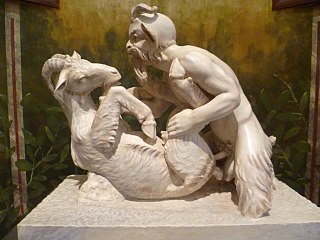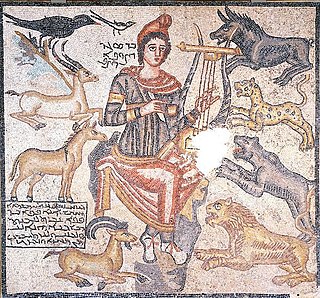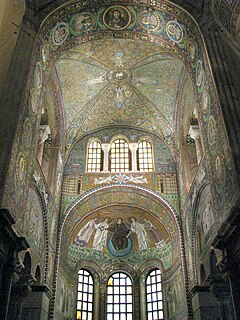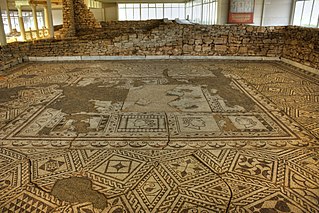
A Roman villa was typically a farmhouse or country house built in the Roman Republic and the Roman Empire, sometimes reaching extravagant proportions.

A mosaic is a pattern or image made of small regular or irregular pieces of colored stone, glass or ceramic, held in place by plaster/mortar, and covering a surface. Mosaics are often used as floor and wall decoration, and were particularly popular in the Ancient Roman world.

Erotic art in Pompeii and Herculaneum has been both exhibited as art and censored as pornography. The Roman cities around the bay of Naples were destroyed by the eruption of Mount Vesuvius in 79 AD, thereby preserving their buildings and artefacts until extensive archaeological excavations began in the 18th century. These digs revealed the cities to be rich in erotic artefacts such as statues, frescoes, and household items decorated with sexual themes. The ubiquity of such imagery and items indicates that the treatment of sexuality in ancient Rome was more relaxed than current Western culture. However, much of what might strike modern viewers as erotic imagery, such as oversized phalluses, could arguably be fertility imagery. Depictions of the phallus, for example, could be used in gardens to encourage the production of fertile plants. This clash of cultures led to many erotic artefacts from Pompeii being locked away from the public for nearly 200 years.

The Villa Romana del Casale is a large and elaborate Roman villa or palace located about 3 km from the town of Piazza Armerina, Sicily. Excavations have revealed one of the richest, largest, and varied collections of Roman mosaics in the world, for which the site has been designated as a UNESCO World Heritage Site. The villa and artwork contained within date to the early 4th century AD.

The Villa of the Mysteries is a well-preserved suburban ancient Roman villa on the outskirts of Pompeii, southern Italy. It is famous for the series of exquisite frescos in one room, which are usually thought to show the initiation of a young woman into a Greco-Roman mystery cult. These are now among the best known of the relatively rare survivals of Ancient Roman painting from the 1st century BC.
Cottanello is a comune (municipality) in the Province of Rieti in the Italian region Latium, located about 60 kilometres (37 mi) north of Rome and about 15 kilometres (9 mi) west of Rieti.

Realmonte is a comune (municipality) in the Region of Agrigento in the Italian Provence Sicily, located about 90 kilometres (56 mi) south of Palermo and about 10 kilometres (6 mi) west of Agrigento.

Brading Roman Villa was a Roman courtyard villa which has been excavated and put on public display in Brading on the Isle of Wight.

Orpheus mosaics are found throughout the Roman Empire, normally in large Roman villas. The scene normally shown is Orpheus playing his lyre, and attracting birds and animals of many species to gather around him. Orpheus was a popular subject in classical art, and was also used in Early Christian art as a symbol for Christ.

Italy has the richest concentration of Late Antique and medieval mosaics in the world. Although the art style is especially associated with Byzantine art and many Italian mosaics were probably made by imported Greek-speaking artists and craftsmen, there are surprisingly few significant mosaics remaining in the core Byzantine territories. This is especially true before the Byzantine Iconoclasm of the 8th century.

Villa Armira is a 1st-century suburban Roman villa in southeastern Bulgaria, located in the proximity of Ivaylovgrad, Haskovo Province. Discovered in 1964 during reservoir construction, it is a primary historical attraction to the Ivaylovgrad area. It is classified as a monument of culture of national importance.

The palatial Late Antique Roman villa at La Olmeda is situated in Pedrosa de la Vega in the province of Palencia, near the banks of the Carrión. Long known as the provenance of chance finds, it was finally professionally excavated from 1968, and was declared a Bien de Interés Cultural, 3 April 1996.

A Roman mosaic is a mosaic made during the Roman period, throughout the Roman Republic and later Empire. Mosaics were used in a variety of private and public buildings, on both floors and walls, though they competed with cheaper frescos for the latter. They were highly influenced by earlier and contemporary Hellenistic Greek mosaics, and often included famous figures from history and mythology, such as Alexander the Great in the Alexander Mosaic.

The Museum of Mosaics is a museum in the town of Devnya in Varna Province, northeastern Bulgaria. The museum, built on top of a large ruined Roman villa from Late Antiquity, exhibits mosaics from the Roman and early Byzantine city of Marcianopolis, as well as other archaeological artifacts.

Paphos Archaeological Park contains the major part of the important ancient Greek and Roman city and is located in Paphos, southwest Cyprus. The park, still under excavation, is within the Nea Pafos section of the coastal city.

The Villa Romana di Patti is a large and elaborate Roman villa located in the comune of Patti in the province of Messina on Sicily.

The Judgement of Paris is the theme of a mosaic from the early second century AD, discovered in 1932 in Antioch. It is one of the most important mosaics from the ancient city, which was located a short distance from the site of modern Antakya (Antioch). The mosaic is normally housed in Paris at the Louvre, although it has been known to go on tour. In 2007 it was scheduled to feature in an itinerant exhibition of important pieces that the Louvre organised in the United States.
The Roman Villa of Bagnoli is located in contrada Bagnoli-San Gregorio, near the town of Capo d'Orlando, Sicily.
The Villa of Gerace is a Roman villa located near Enna along provincial road 78 at the Rastello-Ramata junction, on the Fontanazza estate, Sicily.

The Rutland Roman villa is a Romano-British villa site in Rutland, England. The site was listed as a scheduled monument by Historic England on 23 November 2021. The villa includes the first example of a mosaic in Britain which depicts scenes from Homer's Iliad.




























